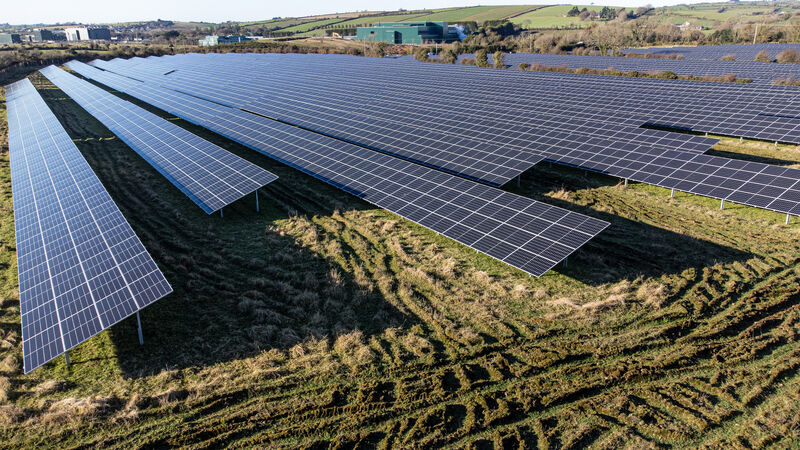Upscaling of wind and solar farms has saved Irish customers nearly €840m

Wind and solar farms saved Irish electricity customers €840m since 2000, according the 'Good for your Pocket' report, published today by consultants Baringa.
Ireland's upscaling of wind and solar farms has saved customers nearly €840m since the turn of the century, with spending on fossil fuels cut by €7.4bn in the same period.
Industry lobby body Wind Energy Ireland's national conference, which begins today, will hear a new report which shows that even based on the most conservative estimate, the financial benefit of developing renewable energy has "significantly outweighed" all possible costs.
Under targets which the Department of Enterprise say are "ambitious", Ireland is aiming to hit five gigawatts (GW) of grid-connected offshore wind plus an additional 2GW of non-grid-connected offshore wind in development by 2030.
By 2040, there is an aim to deliver 20GW of offshore renewable energy, and by 2050, this will rise to 37GW, which is approximately six times our current peak electricity demand.
An EU target of 300GW by 2050 is a key factor when it comes to Ireland's aims too.
Wind and solar farms saved Irish electricity customers €840m since 2000, according to the 'Good for your Pocket' report, published on Thursday by consultants Baringa.
Ireland’s wind generation capacity has grown since 2000 from 117 megawatts (MW) to more than 5,000MW installed across the country, and more than 600MW of solar generation has been connected in recent years.
Last year, according to data from Green Collective, nearly 40% of the country’s electricity came from renewables.
The upscaling of renewable energy sources since 2000 has also cut Irish spending on fossil fuels by €7.4bn and prevented the production of more than 47 million tonnes of CO2 up to the end of 2023.
The savings produced by Ireland’s reduced reliance on imported fossil fuels exceeded the expense of support schemes, grid network development and other costs by close to €840m.
Noel Cunniffe, CEO of Wind Energy Ireland, said that every wind turbine or solar panel that gets built helps Irish families and businesses cut costs.
"Since 2021 alone, renewables have displaced almost €4bn worth of fossil fuels, insulating Irish consumers from the very worst of the impacts of the fossil fuel energy crisis. However, we should still be paying less.
“As long as we maintain our dependency on imported gas, we are letting the price we pay for electricity be dictated to us by international fossil fuel companies."
Ireland currently spends over €1m every hour importing fossil fuels like oil and gas into the State.
However, Mr Cunniffe pointed to the viable alternatives which could lead to a way to "keep the money at home".
"We can build more wind and solar farms, reinforce our electricity grid, electrify our heat and transport systems and work with our EU partners to reform the common electricity market.
"The incoming Government can save Irish consumers millions of euro, while also ensuring a clean, secure, domestic energy supply, and creating thousands of jobs.”
To this point, the Good for Your Pocket report found that should the price of gas remain as high as it is and Ireland manages to reach the agreed target under the Government's Climate Action Plan of 80% renewable electricity, consumer bills could fall by a further €610m from 2030.
Mr Cunniffe said: "The next five years present an opportunity to make unprecedented progress in moving to relying on locally produced renewable energy and accelerating the next phase of Ireland’s economic development.
“By 2030 we can deliver cleaner and more affordable power to hundreds of thousands of homes and businesses across Ireland and lay the foundation for Irish energy independence.”
Research published by Dublin City University in June found that at least two ports are needed to deliver Ireland’s 2030 offshore wind targets.
In October, a new partnership was announced last month between the Port of Cork and the Irish Strategic Investment Fund to support the development of new infrastructure in Cork Harbour.
This is expected to cost over €100m, but the Port of Cork recently secured funding through the EU’s Connecting Europe Facility to assist with costs.
Several other ports across Ireland already have plans to expand their infrastructure. It is hoped that they can be used to build and maintain our offshore wind farms.





